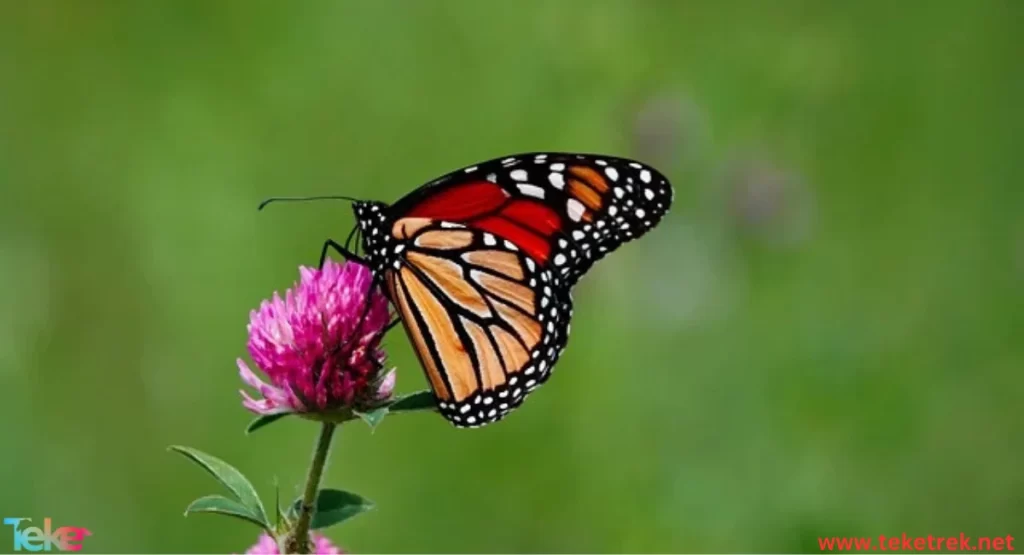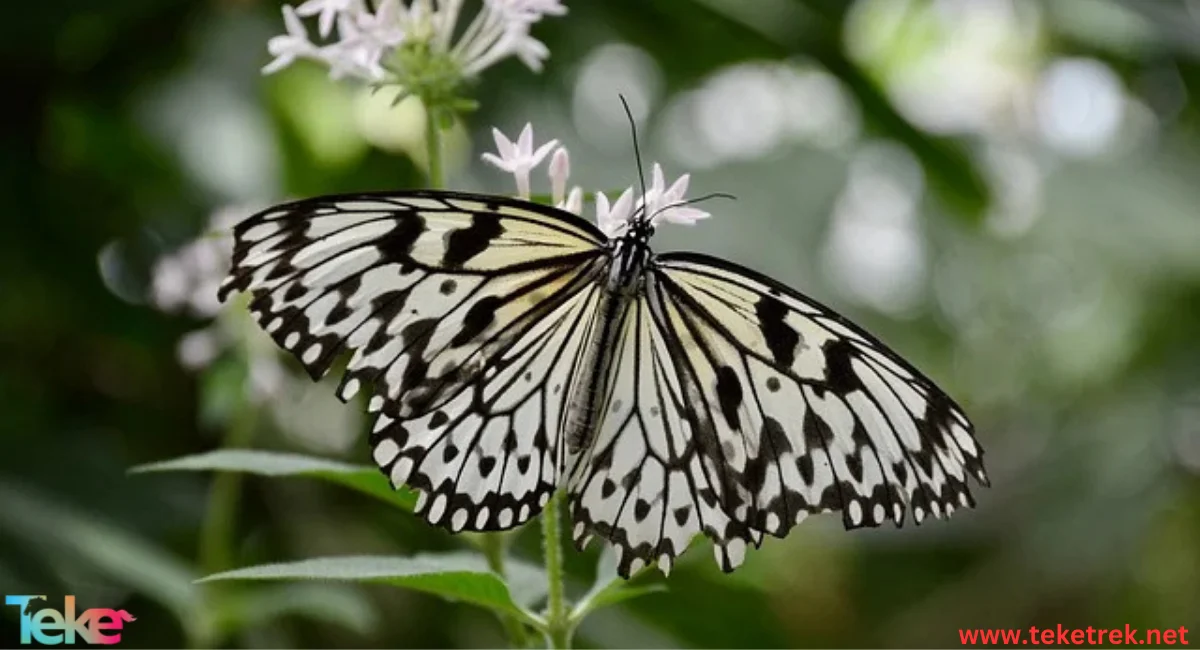Butterflies flutter from one plant to another like flowers with wings painted in rainbow colors. One of the most beautiful creatures that captivate people, they possess unparalleled beauty, with attractive colors and distinct, unique shapes that bring joy to beholders witnessing their astonishing and captivating beauty.
In this article in TekeTrek Website, we will introduce you to the most important information related to this object. Follow along with us.
Butterfly definition and information about it
What is a butterfly? What is the scientific name of the butterfly?
- Butterflies are a type of flying insect belonging to the order Lepidoptera, which includes moths, scientific name: Butterflies.
- They have four wings filled with vibrant colors and six legs.
- Butterflies vary greatly in size, with their weight being less than half a gram, and males are typically larger than females.
- The wingspan of a butterfly ranges from about 0.2 inches to 12 inches (4 to 300 mm).
- The body of a butterfly is divided into the head, thorax, and abdomen.
- They have antennae for sensing located at the front of their heads and eyes on the sides.
- Butterflies have a highly developed sense of taste, especially for sweet flavors.
- They breathe through small openings located on the sides of their bodies.
- There are approximately 100,000 species of butterflies.
Butterfly Habitat
- Butterflies live almost everywhere around the world. All species of butterflies inhabit terrestrial habitats, with their specific habitat varying depending on the species.
- Most species are found in tropical environments and mountain tops.
- They can be found in desert lands, wetlands, grasslands, and forests.
- Some butterflies may spend part of their lives underground, such as butterflies from the Lycaenidae family.
- Butterflies are warm-blooded creatures and do not tolerate cold weather well. In winter, they either enter a state of hibernation or migrate to warmer regions.

Butterfly life cycle
- The lifespan of a butterfly is very short, typically lasting only a few weeks. They reproduce through eggs.
- A butterfly’s life cycle consists of four stages: egg, larva (caterpillar), pupa (chrysalis), and adult butterfly.
- The egg is the first stage of a butterfly’s life and lasts from three to seven days.
- Butterfly eggs are characterized by their small size and cylindrical, oval, or round shape.
- The female butterfly secretes a sticky substance to attach the eggs to leaves. Butterfly eggs have a small opening to allow air and water to enter for the larvae.
- When the butterfly egg hatches, a small worm-like creature called a larva or “caterpillar” appears, which is the second stage of the butterfly’s life.
- Female butterflies choose the male they want to mate with.
Butterfly Features
Butterflies, as living creatures, possess a variety of characteristics and traits that make them unique and fascinating. Here are some features of butterflies:
- Butterflies are distinguished by their vibrant and beautiful colors, which attract attention. The diversity of colors and patterns is one of their distinctive features.
- Butterfly wings are characterized by their transparency and lightness, often adorned with various patterns and colors that aid in self-defense and camouflage.
- Butterflies are known for their elegant and agile flight, utilizing simple movements to glide among flowers, collect nectar, and pollinate plants.
- Butterflies play a crucial role in the environment as pollinators, as their flight between flowers helps transfer pollen and improve plant diversity.
- They differ from other insects in their ability to coil their proboscis.
- They are among the insects favored by humans, as they are harmless, which makes most people enjoy seeing them and not think about harming them.
Butterfly Diet
- Butterflies primarily feed on nectar, the liquid secreted by plants containing sugars and other nutrients. They use their long, coiled proboscis to drink nectar. In addition to nectar, some butterfly species also consume the juices of ripe fruits. Moreover, many butterflies feed on rotting fruits and dung, especially in tropical regions.
- In addition to fluids, some butterfly species require salt and other nutrients found in soil or damp areas. Dietary preferences vary depending on the species and life stage of the butterfly, with caterpillars feeding on plant leaves or fruits before transforming into mature butterflies.
Benefits of Butterflies
- Butterflies add stunning beauty and excitement to any place they inhabit, thanks to their vibrant colors.
- Butterflies are crucial for many plants that rely on insect pollinators for mutual pollination.
- The presence of butterflies serves as evidence that the environment is healthy and suitable for both insects and plants.
- Regions with a wide variety of butterfly species are popular destinations for visitors and tourists alike.
Butterfly species
- Hesperidia (Skippers): Known as “skippers,” this family includes relatively small and fast-flying species. There are about 3000 species of skippers worldwide.
- Lycaenidae (Blues): Colors and patterns often vary between genders. There are over 5000 species of blues worldwide.
- Nymphalidae (Brush-footed Butterflies): Known for their brush-like feet, this family includes numerous subfamilies and comprises about 5000 species worldwide.
- Papilionidae (Swallowtails): Often referred to as “swallowtail butterflies,” most species in this family have prominent “tails.” There are about 600 species worldwide.
- Pieridae (Whites and Yellows): Known for their predominantly white and yellow colors, there are over 1000 species of whites and yellows worldwide.
- Riodinidae (Metalmarks): Sometimes called “metalmarks,” they are occasionally placed within the Lycaenidae family. There are around 1000 species worldwide.


Frequently Asked Questions
- What does the butterfly symbolize in Islam?
The butterfly symbolizes transformation and renewal in Islam, representing new life and spiritual renewal.
- What are the characteristics of butterflies?
- Beauty: They are characterized by their vibrant and attractive colors.
- Agility: They have the ability to fly gracefully and swiftly.
- Ecological role: They play a crucial role in pollination and enhancing plant diversity.
- Symbolism: They symbolize transformation and renewal in many cultures.
- Do butterflies bite humans?
No, butterflies do not bite humans. In fact, butterflies do not have mouths capable of biting or stinging. They feed only on liquids, such as nectar and fruit juices. Therefore, they pose no danger to humans and do not cause harm.
- When do butterflies die?
The lifespan of a butterfly varies among species and environmental conditions. Generally, the lifespan of a butterfly is relatively short, ranging from a few days to several weeks only.
- What are the details of a butterfly?
Butterflies have four delicate wings covered in scales, antennae for sensory perception, a long proboscis for feeding, six legs for walking and clinging, a segmented body, compound eyes, and colorful scales on their wings and body. These details contribute to their beauty and functionality in nature.
- What do butterflies symbolize?
Butterflies symbolize transformation, renewal, and spiritual rebirth across various cultures and belief systems. They are often associated with the soul, growth, and the journey of life. Seeing a butterfly can represent personal growth, positive change, and the emergence of new beginnings. In some cultures, butterflies are also seen as messengers from the spirit world or symbols of endurance, hope, and resilience.
- Is the butterfly an arthropod?
Yes, a butterfly is an insect, so it is an arthropod.
- How long does a butterfly live?
The butterfly lives for a maximum of two weeks.
Conclusion
The butterfly remains a beloved creature associated with countless memories, an enduring symbol of love that never fades. Despite being insects, they are bestowed with a delicate and enchanting nature by God. They have inspired poets, painters, and artists throughout the ages with their ability to capture hearts and eyes.






